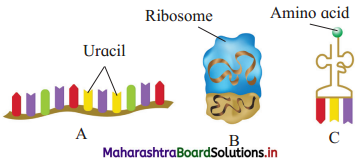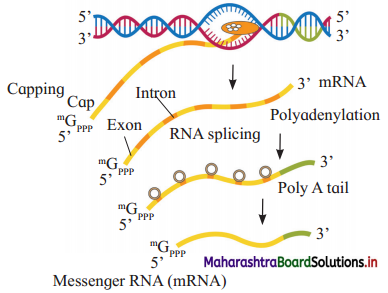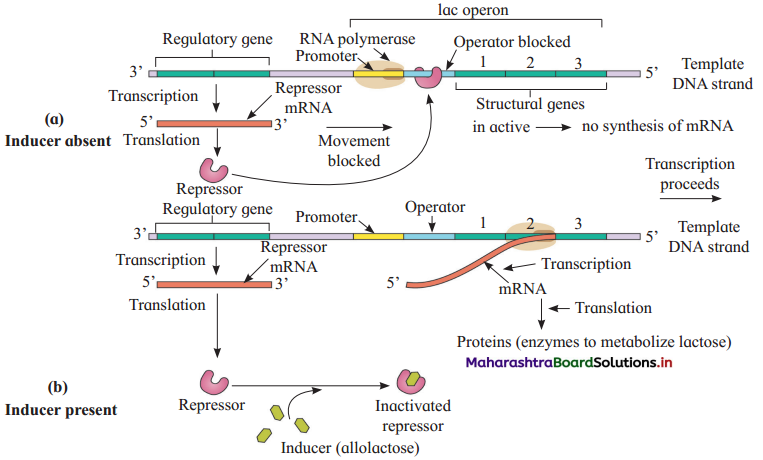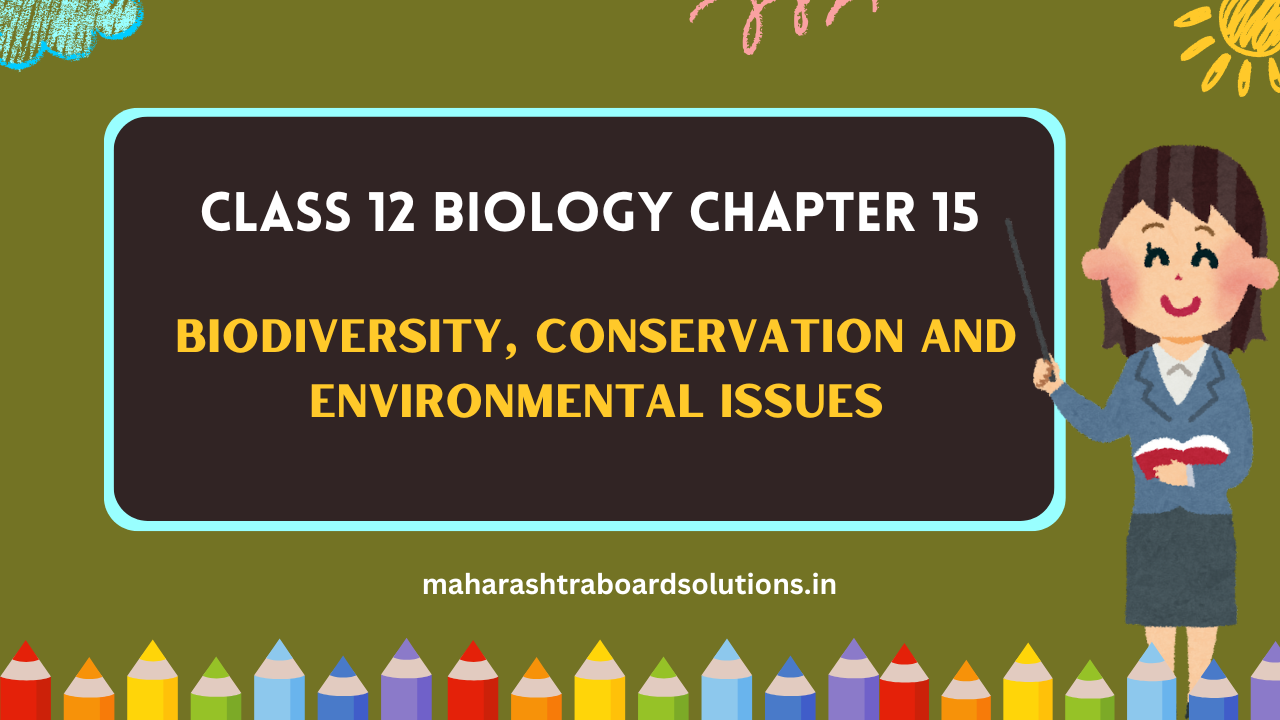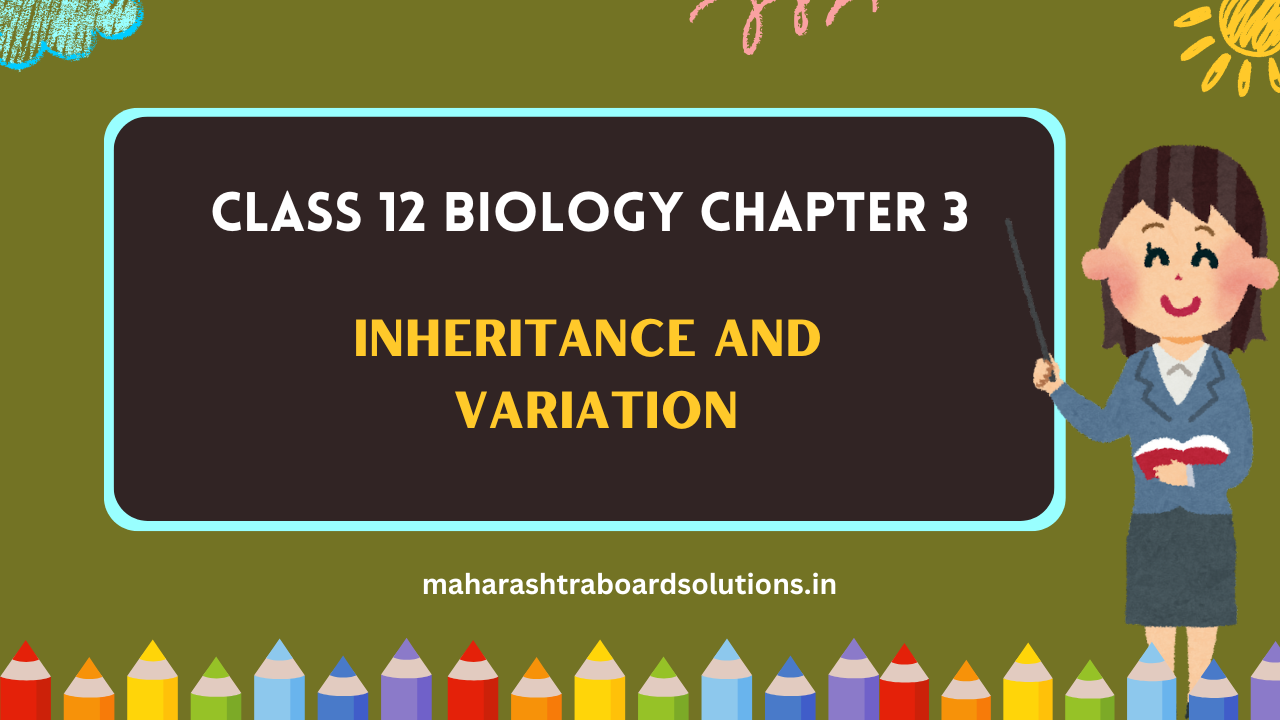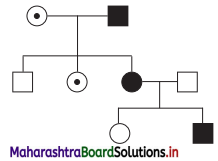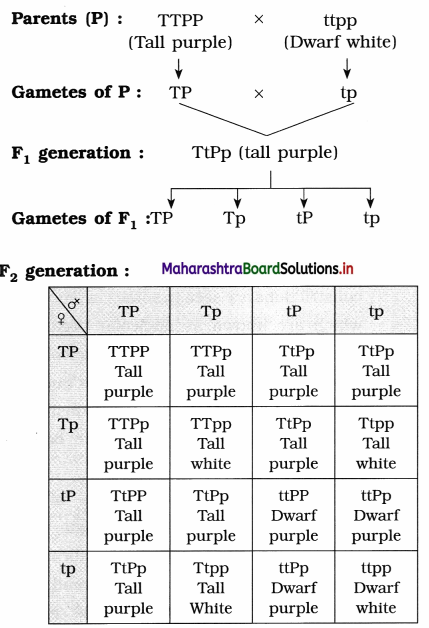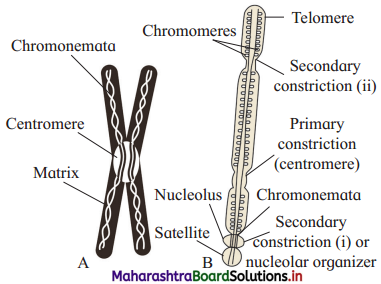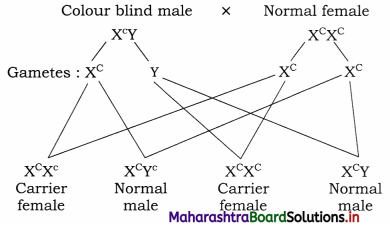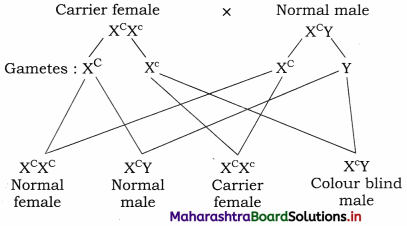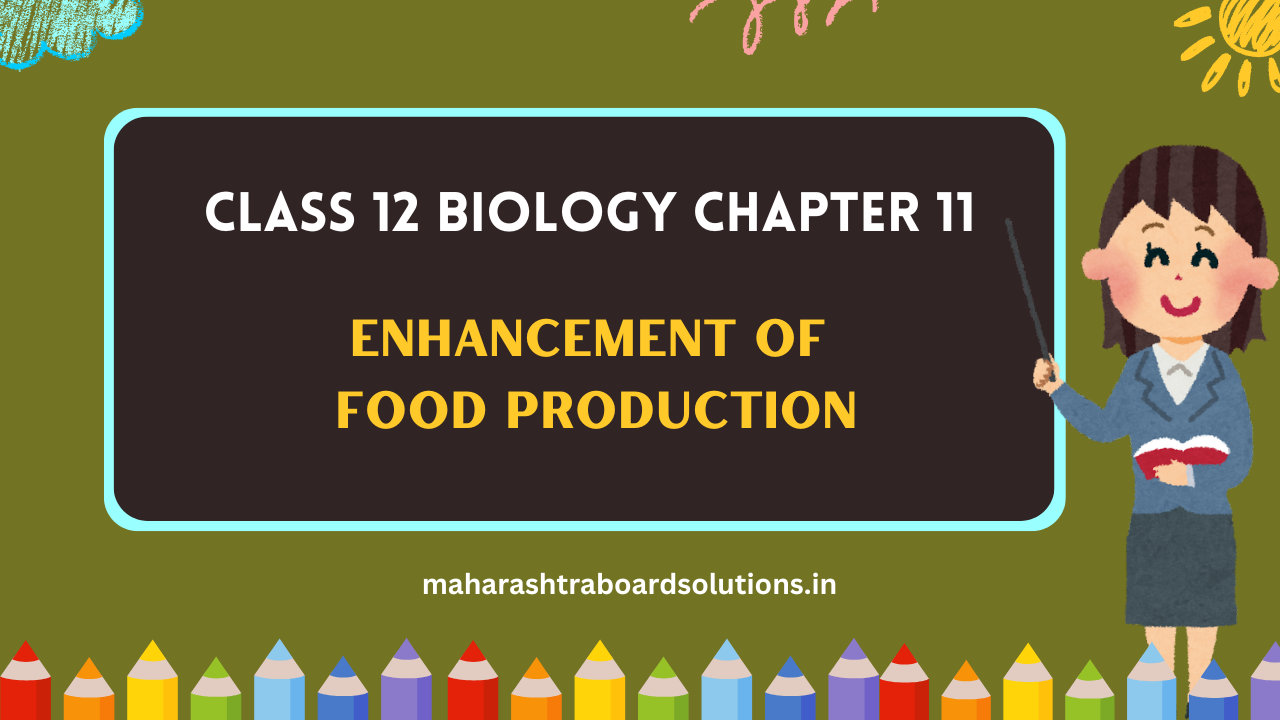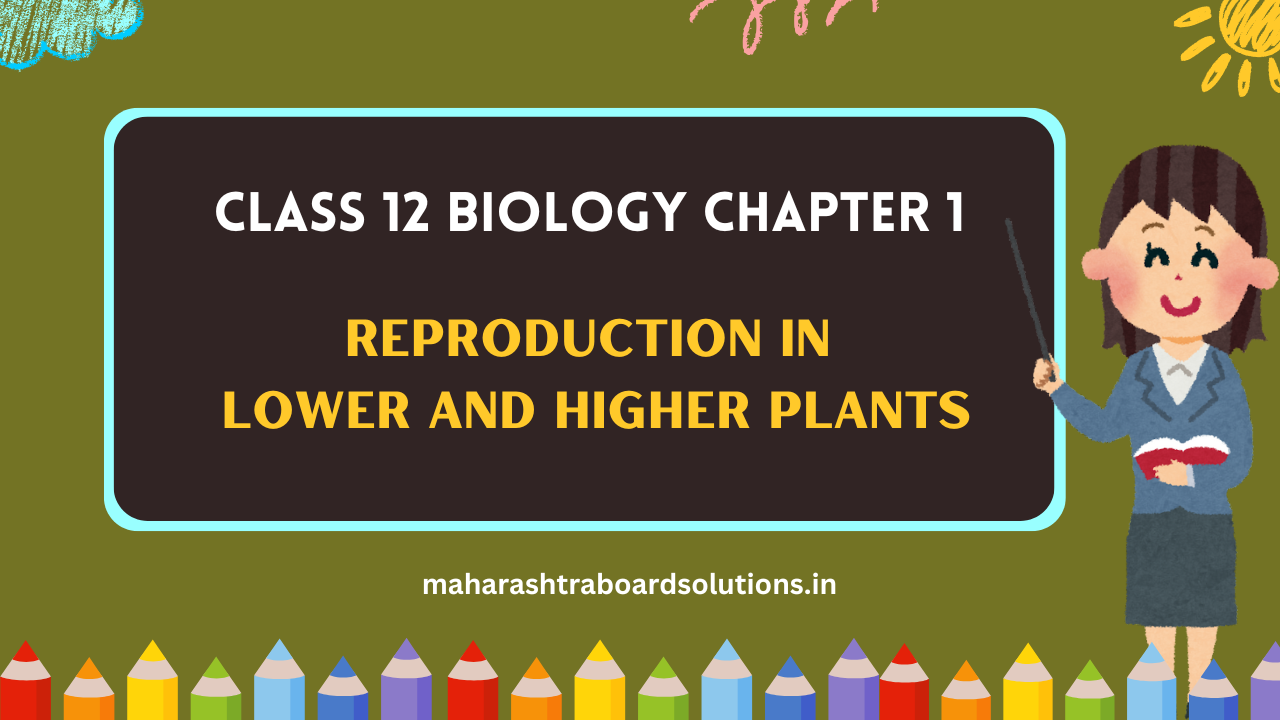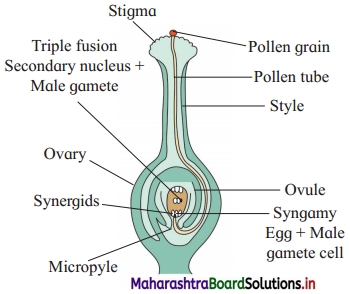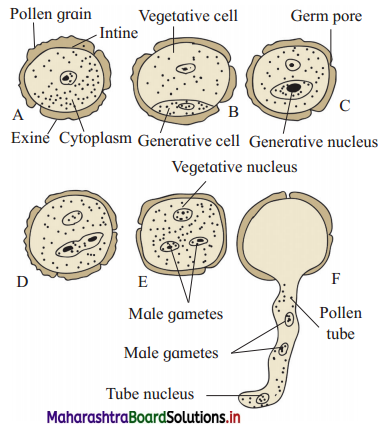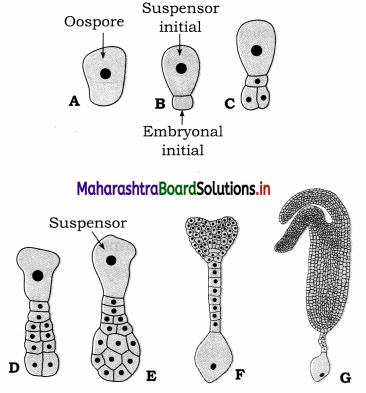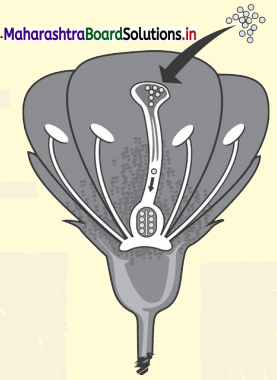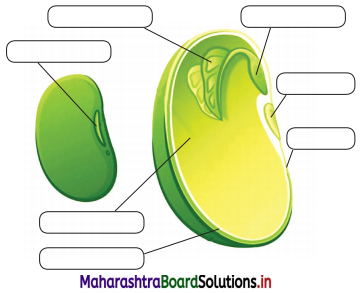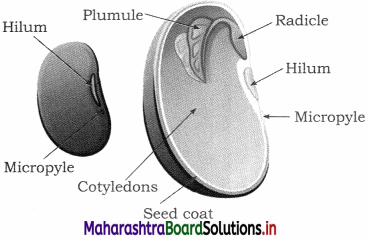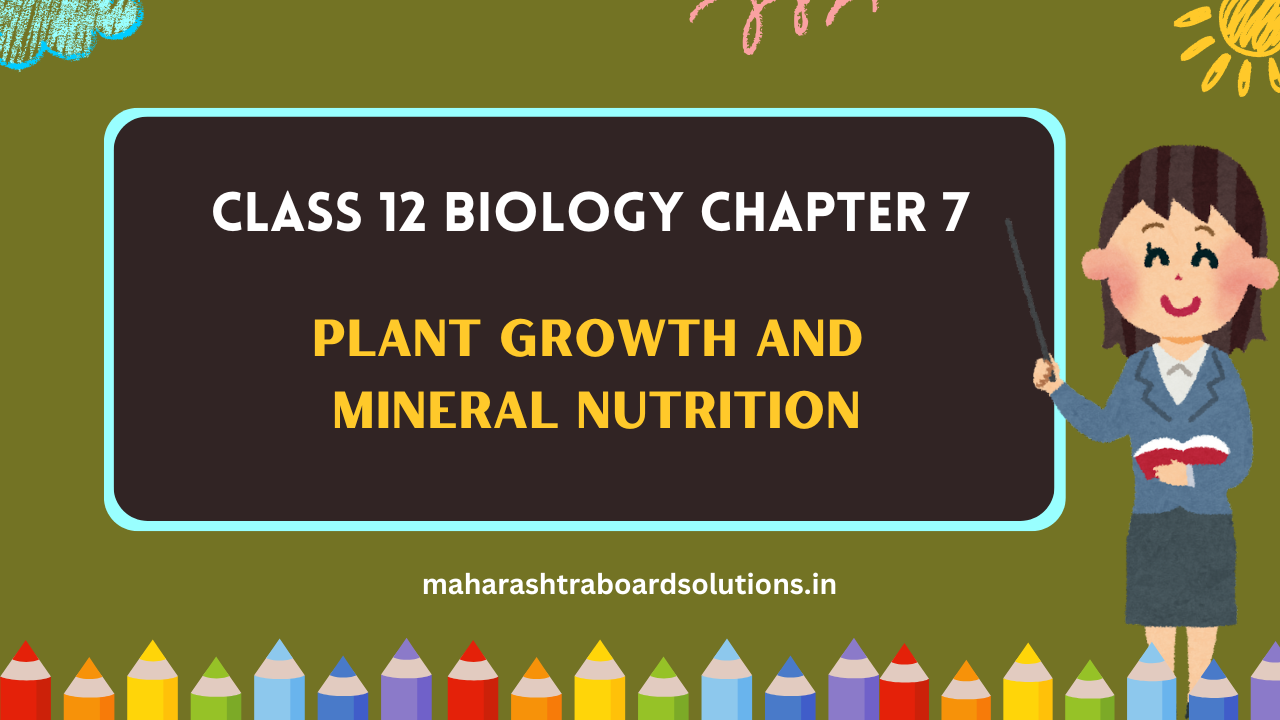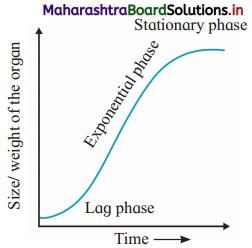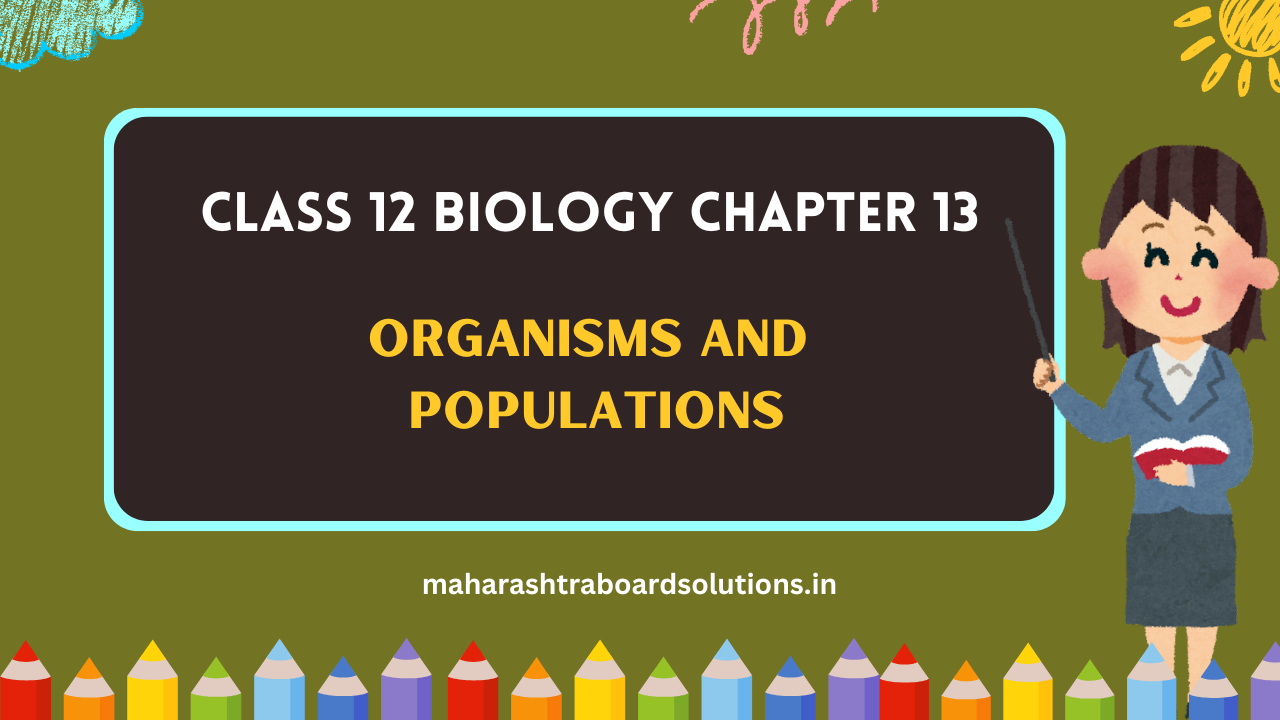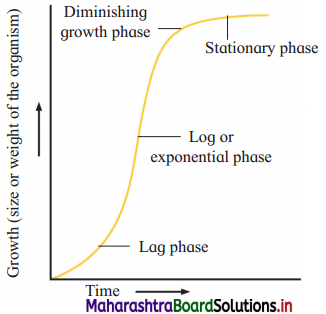Balbharti Maharashtra State Board 12th Biology Textbook Solutions Chapter 10 Human Health and Diseases Textbook Exercise Questions and Answers.
Human Health and Diseases Class 12 Exercise Question Answers Solutions Maharashtra Board
Class 12 Biology Chapter 10 Exercise Solutions Maharashtra Board
Biology Class 12 Chapter 10 Exercise Solutions
1. Multiple Choice Questions
Question 1.
Which of the following is NOT caused by unsterilized needles?
(a) Elephantiasis
(b) AIDS
(e) Malaria
(d) Hepatitis
Answer:
(a) Elephantiasis
Question 2.
Opium derivative is …………………
(a) Codeine
(b) Caffeine
(c) Heroin
(d) Psilocybin
Answer:
(c) Heroin
![]()
Question 3.
The stimulant present in tea is …………………
(a) tannin
(b) cocaine
(C) caffeine
(d) crack
Answer:
(c) caffeine
Question 4.
WhIch of the following Is caused by smoking?
(a) Liver cirrhosis
(b) Pulmonary tuberculosis
(c) Emphysema
(d) Malaria
Answer:
(c) Emphysema
Question 5.
An antibody is …………………
(a) molecuic that binds specifically an antigen
(b) WBC which invades bacteria
(c) secretion of mammalian RBC
(d) cellular component of blood
Answer:
(a) molecule that binds specifically an antigen
Question 6.
The antiviral proteins released by a virus-infected cell are called …………………
(a) histamines
(b) interferons
(c) pyrogens
(d) allergens
Answer:
(b) interferons
Question 7.
Both B-cells and T-cells are derived from …………………
(a) lymph nodes
(b) thymus glands
(c) liver
(d) stem cells in bone marrow
Answer:
(b) thymus glands
Question 8.
Which of the following diseases can be contracted by droplet infection?
(a) Malaria
(b) Chicken pox
(c) Pneumonia
(d) Rabies
Answer:
(c) Pneumonia
Question 9.
Confirmatory test used for detecting HIV infection is …………………
(a) ELISA
(b) Western blot
(c) Widal test
(d) Eastern blot
Answer:
(b) Western blot
Question 10.
Elephantiasis is caused by …………………
(a) W. barterofti
(b) P. vivax
(c) Bedbug
(d) Elephant
Answer:
(a) W. bancrofti
Question 11.
Innate immunity is provided by …………………
(a) phagocytes
(b) antibody
(c) T-lymphocytes
(d) B-lymphocytes
Answer:
(c) T-lymphocytes
2. Short Answer Questions
Question 1.
What is the source of cocaine?
Answer:
Source of cocaine is coca plant – Erythroxylum coca.
Question 2.
Name one disease caused by smoking.
Answer:
Emphysema. (Damaged and enlarged lungs causing breathlessness)
Question 3.
Which cells stimulate B-cells to form antibodies ?
Answer:
Helper T-cells stimulate B-cells to form antibodies.
Question 4.
What does the abbreviation AIDS stand for?
Answer:
AIDS stands for Acquired Immuno Deficiency Syndrome.
Question 5.
Name the causative agent of typhoid fever.
Answer:
Salmonella typhi
Question 6.
What is Rh factor?
Answer:
Antigen ‘D’ present on the surface of RBCs is known as Rh factor.
Question 7
What is schizont?
Answer:
Schizont is a ring-like form produced from merozoites inside the erythrocytes of human beings, infected by Plasmodium, which again forms new merozoites.
Question 8.
Name the addicting component found in tobacco.
Answer:
Nicotine
![]()
Question 9.
Name the pathogen causing Malaria.
Answer:
Plasmodium vivax
Question 10.
Name the vector of Filariasis.
Answer:
Female Culex mosquito
Question 11.
Name of the causative agent of ringworm.
Answer:
Trichophyton
Question 12.
Health
Answer:
Health is defined as the state of complete physical, mental and social well¬being and not merely the absence of disease or infirmity.
3. Short Answer Questions
Question 1.
What are acquired diseases?
Answer:
Diseases which are developed after the birth of an individual are called acquired diseases. These are of two types, viz. (a) Communicable or infectious diseases and (b) Non- communicable or Non-infectious diseases. Communicable or infectious diseases are transmitted from infected person to another healthy person either directly or indirectly. They are caused due to pathogens like viruses, bacteria, fungi, helminth worms, etc. Non-communicable or Non-infectious diseases cannot be transmitted from infected person to another healthy one either directly or indirectly.
Question 2.
Antigen and antibody.
Answer:
| Antigen | Antibody |
| 1. Antigens are foreign proteins which are capable of producing infection. | 1. Antibodies are immunoglobulins produced by the body to act against the antigens. |
| 2. The structure of antigens is variable dependent upon the type of pathogen. | 2. The structure of antibody is Y-shaped. |
| 3. The antigen is the ‘non-self’ molecule. | 3. The antibody is ‘self’ molecule. |
| 4. The antigens have epitope sites which bind with the antibody molecule. | 4. The antibodies have paratope sites which bind with the antigen molecule. |
Question 3.
Name the infective stage of Plasmodium. Give Symptoms of malaria
Answer:
Sporozoite
I. Symptoms of malaria:
- Fever accompanied by shivering.
- Joint pain or arthralgia.
- Vomiting.
- Anaemia caused due to rupture of RBCs or haemolysis.
- Haemoglobinuria.
- Retinal damage.
- Convulsions.
- Cyclical occurrence of sudden coldness followed by rigor and then fever and sweating lasting for four to six hours. This is called a classic symptom of malaria.
- Splenomegaly or enlarged spleen, severe headache, cerebral ischemia, hepatomegaly, i. e. enlarged liver, hypoglycaemia and haemoglobinuria with renal failure may occur in severe infections.
II. Spread / Transmission of malaria:
- Malaria parasite is transmitted through the female Anopheles mosquito and hence it is known as mosquito-borne disease. Mosquito acts as a vector.
- There are four species of Plasmodium, viz., P. vivax, P. falciparum, P. ovale and P. malariae which transmit malaria.
Question 4.
Explain the mode of infection and cause of elephantiasis.
Answer:
Mode of infection, i.e. transmission:
- The parasite Wuchereria bancrofti is transmitted from a patient to other normal human being by female Culex mosquito.
- The filarial larvae leave mosquito body and arrive on the human skin where they penetrate the skin and enter inside.
- They undergo two moultings to become adults. Later they settle in the lymphatic system. They incubate for about 8-16 months.
- When they settle in lymphatic system, this infection is called lymphatic filariasis.
- The worms start infecting lymphatic circulation resulting into enlargement of lymph vessels and lymph nodes. The extremities like legs or limbs become swollen which resembles elephant legs. Therefore it is called elephantiasis.
- This condition is lymphoedema, i.e. accumulation of lymph fluid in tissue causing swelling.
Question 5.
Why is smoking a bad habit?
Answer:
- Smoking involves inhaling the cigarette smoke which contains nicotine and other toxic substances like N-nitrosodimethlene. There is some amount of carbon monoxide.
All these substances affect the normal respiratory health. - Smoking invites problems like asthma, hypertension, heart disease, stroke, lung damage.
- The worst impact is that these substances are carcinogenic and hence can cause cancer of larynx, trachea, lung, etc.
- Smoking not only affects the smokers but also has bad effect on others due to passive smokers.
- In women, smoking is still hazardous as their ovaries can undergo mutations due to mutagenic chemicals found in smoke.
- Therefore, smoking is a very bad habit.
Question 6.
What do the abbreviations AMIS and CMIS denote?
Answer:
AMIS is Antibody-mediated immune system or humoral immunity and CMIS is cell- mediated immune system.
Question 7.
What is a carcinogen? Name one chemical carcinogen with its target tissue.
Answer:
- Carcinogen is the substance or agent that causes cancer.
- Urinary bladder cancer caused by 2-naphthylamine and 4-aminobiphenyl.
Question 8.
Active immunity and passive immunity.
Answer:
| Active immunity | Passive immunity |
| 1. Active immunity is produced in response to entry of pathogens and their antigenic stimuli. | 1. Passive immunity is produced due to antibodies that are transferred to the body. |
| 2. Active immunity is the long lasting immunity. | 2. Passive immunity is short-lived immunity. |
| 3. In active immunity, the body produces its own antibodies. | 3. In passive immunity, antibodies are given to the body from outside. |
| 4. Natural acquired active immunity is obtained due to infections by pathogens. | 4. Natural acquired passive immunity is obtained through antibodies of mother transmitted- to baby by placenta or colostrum. |
| 5. Artificial acquired active immunity is obtained through vaccinations. These vaccines contain dead or live but attenuated pathogens. | 5. Artificial acquired passive immunity is also obtained through vaccinations, but here the vaccines contain the readymade antibodies which are prepared with the help of other animals such as horses. |
4. Short Answer Questions
Question 1.
B-cells and T-cells.
Answer:
| B-cells | T-cells. |
| 1. B-cells are type of lymphocyte whose origin is in bone marrow but maturation is in blood. | 1. T-cells are type of lymphocytes which originate in bone marrow but maturation occurs in thymus. |
| 2. B-cells Eire type of lymphocytes which are involved in humoral mediated immunity. | 2. T-cells are type of lymphocytes which are involved in cell-mediated immunity. |
| 3. 20% of lymphocytes present in the blood are B-cells. | 3. 80% of lymphocytes present in the blood are T-cells. |
| 4. Two types of B-cells are Memory cells and Plasma cells. | 4. T-cells are of following subtypes : Cytotoxic T-cells, helper T-cells, suppressor T-cells. |
| 5. They are involved in antibody mediated immunity. (AMI) | 5. They are involved in cell-mediated immunity (CMI). |
| 6. B-cells produced antibodies with which they fight against pathogens. | 6. T-cells do not produce antibodies. |
| 7. B-cells have membrane bound immunoglobulins located on the surface. | 7. There is a presence of T cell receptors on the T-cell surface. |
![]()
Question 2.
What are the symptoms of malaria? How does malaria spread?
Answer:
Symptoms of malaria:
- Fever accompanied by shivering.
- Joint pain or arthralgia.
- Vomiting.
- Anaemia caused due to rupture of RBCs or haemolysis.
- Haemoglobinuria.
Question 3.
AIDS.
Answer:
(1) AIDS or the acquired immuno deficiency syndrome, is fatal viral disease caused by a retrovirus (ss RNA) known as the human immuno deficiency virus (HIV) which weakens the body’s immune system. It is called a modern pandemic.
(2) The HIV attacks the immune system which in turn causes many opportunistic infections, neurological disorders and unusual malignancies ultimately leading to death.
(3) AIDS was first noticed in USA in 1981 whereas in India, first confirmed case of AIDS was in April 1986 from Tamil Nadu.
(4) HIV is transmitted through body fluids such as saliva, tears, nervous system tissue, spinal fluid, blood, semen, vaginal fluid and breast milk. However, only blood, semen, vaginal secretions and breast milk generally transmit infection to others.
(5) The transmission of HIV occurs by sexual contact, through blood and blood products and by contaminated syringes, needles, etc. There is also transplacental transmission or through breast milk at the time of nursing.
(6) Accidental needle injury, artificial insemination with infected donated semen and transplantation with infected organs are some of the rare occasions of transmission of HIV.
(7) HIV infection is not spread by casual contact such as hugging, bite of mosquitoes or using other objects touched by a patient.
(8) Acute HIV infection progresses over time to asymptomatic HIV infection and then to early symptomatic HIV infection. Later, it progresses to full blown AIDS when patient shows advanced HIV infection with CD4 T-cell count below 200 cells/mm.
Question 4.
Give the symptoms of cancer.
Answer:
Symptoms of cancer:
- Presence of lump or tumour.
- White patches in the mouth.
- Change in a wart or mole on the skin.
- Swollen or enlarged lymph nodes.
- Vertigo, headaches or seizures if cancer affect the brain.
- Coughing and shortness of breath if lungs are affected due to cancer.
Question 5.
Antigens on blood cells.
Answer:
- There are about 30 known antigens on the surface of human red blood cells. They decide the type of blood group such as ABO, Rh, Duffy, Kidd, Lewis, P MNS, Bombay.
- The different blood groups are determined genetically due to presence of a particular antigen.
- Landsteiner found two antigens or agglutinogens on the surface of human red blood cells which are named as antigen A and antigen B.
- There is another antigen called Antigen D which decides the Rh status of the blood. If Antigen D is present, the person is said to be RH positive and when it is lacking, the person is Rh negative.
- These antigens are responsible for types of blood group and the specific transfusions.
- Antigens present on the RBCs and antibodies present in the serum can cause agglutination reactions if they are non-compatible. Therefore, at the time of transfusion blood groups are checked properly.
Question 6.
Antigen-antibody complex:
Img 1
Answer:
- Between antigen and antibody there is specificity.
- Each antibody is specific for a particular antigen.
- On the antigens there are combining sites which are called antigenic determinants or epitopes.
- Epitopes react with the corresponding antigen binding sites of antibodies which are called paratopes.
- The antigen binding sites are located on the variable regions of the antibody. Variable regions have small variations which make each antibody highly specific for a particular antigen.
- Owing to variable region the antibody can recognize the specific antigen.
- Antibody thus binds to specific antigen in a lock and key manner, forming an antigen- antibody complex.
Question 7.
What are the various public health measures, which you would suggest as safeguard against infectious diseases?
Answer:
Infectious diseases spread through pathogens, therefore, it is an important duty of each person to decrease the risk of infecting our own self or others. This can be achieved by
- Washing hands often, especially whenever, we are in contact with food and water. Before and after preparing food, before eating and after using the toilet, hand wash is a must.
- Vaccinations : Immunization helps us to protect against contracting many diseases. Therefore, timely vaccination should be taken. Especially at the time of epidemic, one must keep distance from infected area or get vaccinated.
- One must be at home if there are signs and symptoms of an infection. By going out, we may infect other healthy persons.
- Proper diet and exercise should be followed to improve one’s own immunity.
- Hygiene should be utmost in the kitchen and dining area. One must take care while eating uncovered and leftover food.
- Bathroom and toilet should be cleaned daily as there can be a high concentration of bacteria or other infectious agents in these areas.
- One should have responsible sexual behaviour to avoid sexually transmitted diseases.
- Personal items such as toothbrush, comb, towel, undergarments or razor blade should never be shared.
- Travelling should be avoided because we may infect other passengers during travel. Moreover, our illness can be aggravated. Some special immunizations are needed during certain travels, such as anti-cholera vaccine while going to Pandharpur during Ashadhi.
Question 8.
How does the transmission of each of the following diseases take place?
(a) Amoebiasis:
Answer:
Amoebiasis is usually transmitted by the following ways:
- The faecal-oral route.
- Through contact with dirty hands or objects.
- By anal-oral contact.
- Through contaminated food and water.
(b) Malaria:
Answer:
Symptoms of malaria:
- Fever accompanied by shivering.
- Joint pain or arthralgia.
- Vomiting.
- Anaemia caused due to rupture of RBCs or haemolysis.
- Haemoglobinuria.
(c) Ascariasis:
Answer:
- Unsafe and unhygienic food and drinks contaminated with the eggs of Ascaris are the main mode of transmission.
- Eggs hatch inside the intestine of the new host.
- The larvae pass through various organs and settle as adults in the digestive system.
(d) Pneumonia:
Answer:
- Pneumonia usually spreads by direct person to person contact.
- It is also spread via droplet infection, i.e. droplets released by infected person.
- Using clothes and utensils of the patient.
Question 9.
What measures would you take to prevent water-borne diseases?
Answer:
- To prevent water-borne diseases, use of safe, clean and potable water is a must. Water should be filtered, then boiled and stored in covered container. If possible water purifier systems should be installed at home.
- One should preferably use bottled water or carry our own water container while travelling.
- Cleaning of water containers and maintaining personal hygiene near water storage is a must.
- Megacities offer chlorinated and purified water for citizens. But villages and smaller rural set ups use river water which may be highly contaminated with pathogens. Such water should be purified before consumption to prevent water-borne diseases.
![]()
Question 10.
Typhoid.
Answer:
Typhoid is an infective disease caused by Gram-ve bacterium, Salmonella typhi.
(1) It is food and water-borne infection. In the intestinal lumen of infected person this bacteria is found.
(2) The bacterium has “O” – antigen, which is a lipopolysaccharide (LPS), present on surface coat and its flagella has “H” – antigen. Thus it becomes pathogenic.
(3) Signs and Symptoms of typhoid are as follows:
Prolonged and high fever with nausea, fatigue, headache.
Abdominal pain, constipation or diarrhoea. In severe cases rose-coloured rash is seen on skin. Tongue shows white coating and there is cough. Anorexia or loss of appetite is seen. In chronic cases there is breathlessness, irregular heartbeats and haemorrhage.
(4) Poor hygiene habits and poor sanitation and insects like houseflies and cockroaches spread typhoid.
(5) Typhoid is diagnosed by Widal test.
(6) Antibiotics like Chloromycetin can cure typhoid. Preventive vaccines such as oral Ty21a vaccine and injectable typhim vi and typherix against typhoid are also available. Chronic cases need surgical removal of gall bladder.
5. Match the following.
| Column I | Column II |
| (a) AIDS | (i) Antibody production |
| (b) Lysozyme | (ii) Activation of B-cells |
| (c) B-cells | (iii) Immunoglobulin |
| (d) T-helper cells | (iv) Tears |
| (e) Antibody | (v) Immuno deficiency |
Answer:
| Column I | Column II |
| (a) AIDS | (v) Immuno deficiency |
| (b) Lysozyme | (iv) Tears |
| (c) B-cells | (i) Antibody production |
| (d) T-helper cells | (ii) Activation of B-cells |
| (e) Antibody | (iii) Immunoglobulin |
6. Long Answer Questions
Question 1.
Describe the structure of antibody.
Answer:
Img 2
- Antibodies are highly specific to specific antigens. They are glycoprotein called immunoglobulins (Igs.).
- They are produced by plasma cells. Plasma cells are in turn formed by B-lymphocytes.
- About 2000 molecules of antibodies are formed per second by the plasma cells.
- Antibody is a ‘Y’-shaped molecule. It has four polypeptide chains, two heavy or H-chains and two light or L-chains.
- Disulfide bonds (-s-s-) hold the polypeptide chains together to form a ‘Y’-shaped structure.
- The region holding arms and stem of antibody is termed as hinge. Each chain of the antibody has two distinct regions, the variable region and the constant region.
- Variable regions have a paratope which is an antigen-binding site. This part of antibody recognizes and binds to the specific antigen forming an antigen-antibody complex.
- Antibodies are called bivalent as they carry two antigen binding sites.
Question 2.
Vaccination.
Answer:
- Vaccines are prepared from inactivated pathogen, in the form of protein or sugar from pathogen or dead form of pathogen or toxoid from pathogens or attenuated pathogen.
- These when they are administered to a person to protect against a particular pathogen, it is called vaccination.
- Vaccination ’teaches’ the immune system to recognize and eliminate pathogenic organism. Because, already in the body the vaccine is injected and body has made antibodies in response to it. Thus, body is prepared before the attack, if at all it is exposed to pathogen.
- Thus, it is an important form of primary prevention, which reduces the chances of illness by protecting people. It works by exposing the pathogen in a safe form.
- Vaccinations control spread of diseases like measles, polio, tetanus and whooping cough that once threatened many lives.
- Vaccination controls the epidemic outbreak of diseases, if all the people Eire pre-vaccinated.
- Some hazardous diseases like small, pox and polio have been completely eradicated by the vaccination.
Question 3.
What is cancer? Differentiate between benign tumour and malignant tumour. The main five types of cancer
Answer:
I. Cancer : Cancer is a disease caused by uncontrolled cell division due to disturbed cell cycle.
II. Difference between benign tumour and malignant tumour:
| Benign tumour | malignant tumour |
| 1. Benign tumour is localized and it does not spread to neighbouring areas. | 1. Malignant tumour starts as local but spreads rapidly to neighbouring areas. |
| 2. Benign tumour is enclosed in connective tissue sheath. | 2. Malignant tumour is not enclosed in connective tissue sheath. |
| 3. Benign tumour compresses the surrounding normal tissue. | 3. Malignant tumour invades and destroys the surrounding tissue. |
| 4. Benign tumours can be removed surgically. | 4. Malignant tumours need further treatment after removal. |
| 5. Except for brain tumour, benign tumours are usually not fatal. | 5. Malignant tumours are fatal. |
| 6. Benign tumours do not show metastasis. | 6. Malignant tumours show metastasis. |
| 7. Benign tumours are well differentiated. | 7. Malignant tumours are poorly differentiated. |
| 8. Benign tumours show slow and progressive growth. | 8. Malignant tumours show rapid and erratic growth. |
III. The main five types of cancer:
Types of Cancer : According to the tissue affected, the cancers are classified into five main types. These are as follows:
- Carcinoma : Cancer of epithelial tissue covering or lining the body organs is known as carcinoma. E.g. breast cancer, lung cancer, cancer of stomach, skin cancer, etc.
- Sarcoma : Cancer of connective tissue is called sarcoma. Following are the types of sarcoma osteosarcoma (bone cancer), myosarcoma (muscle cancer),
chondrosarcoma (cancer of cartilage) and liposarcoma (cancer of adipose tissue). - Lymphoma : Cancer of lymphatic tissue is called lymphoma. Lymphatic nodes, spleen and tissues of immune system are affected due to lymphoma.
- Leukaemia : Leukaemia is blood cancer. In this condition, excessive formation of leucocytes take place in the bone marrow. There are millions of abnormal immature leucocytes which cannot fight infections. Monocytic leukaemia, lymphoblastic leukaemia, etc. are the types of leukaemia.
- Adenocarcinoma : Cancer of glandular tissues such as thyroid, pituitary, adrenal, etc. is called adenocarcinoma.
![]()
Question 4.
Describe the different type of immunity.
Answer: There are two basic types of immunity, viz. innate immunity and acquired immunity.
(A) Innate immunity:
- Innate immunity is natural, inborn immunity, which helps the body to fight against the invasion of microorganisms.
- Innate immunity is non-specific because it does not depend on previous exposure to foreign substances.
- Innate immunity mechanisms consist of various types of barriers such as anatomical barriers, physiological barriers, phagocytic barriers and inflammatory barriers. They prevent entry of foreign agents into the body.
(B) Acquired immunity:
- The immunity that an individual acquires during his life is called acquired immunity or adaptive immunity or specific immunity. It helps the body to adapt by fighting against specific antigens hence it is called adaptive immunity. Since it is produced specifically against an antigen, it is called specific immunity.
- Acquired immunity takes long time for its activation.
- This type of immunity is seen only in vertebrates.
- Due to acquired immunity, the body is able to defend against any invading foreign agent.
Question 5.
Describe the ill-effects of alcoholism on health.
Answer:
- Alcohol in any form is toxic for the body. Hence as soon as alcohol is consumed, the liver tries to detoxify it.
- In low doses it acts as a stimulant but in high dose, it acts on central nervous system, especially the cerebrum and cerebellum. Still higher dose can induce a comatose condition.
- Alcohol affect the gastrointestinal tract by causing inflammation and damage to gastric 4 mucosa. Ulceration and painful condition arises in alcoholics.
- Excessive doses of alcohol induce vomiting.
- The worst effect of alcohol is on liver causing diseases like cirrhosis.
- Alcohol induces hypertension and cardiac problems.
- Apart from physical effect, it causes deterioration of mental health and emotional well-being.
- Alcoholic person cannot think due to numbness in his/her cerebrum.
- The social health is greatly affected as the alcoholic can cause problems to his family, friends and society in general.
Question 6.
In your view, what motivates the youngsters to take to alcohol or drugs and how can this be avoided?
Answer:
I. Taking drugs or alcohol:
- Youngsters are at the vulnerable age, where they lack the planning about their future.
- If they fall into bad company or are facing parental neglect, they get hooked on to alcohol or drugs.
- Some common causes for addiction among youngsters are insufficient parental supervision and monitoring or excessive pressure and expectations from them. Lack of communication between an adolescent and parents.
- Poorly defined rules for the family. Continuous family conflicts.
- Favourable parental attitudes towards alcohol and drug uses. Many a times, at home children are exposed to such habits.
- Inability to cope up with present and hence switching to the addictions. Risk taking behaviour which is common among youngsters.
II. Methods/measures to avoid drug abuse:
- There should be complete acceptance for the child, because the adolescent phase is the most crucial phase when the children should be treated with love, care and respect.
- Many physical, hormonal and psychological transformations are taking place in this phase. Therefore child suffers from stressful situation.
- Wrong company and bad influence of peer group can trap the child in bad addictive habits. Thus, family should be supportive and communicative to help such children.
- The sexual thoughts should be sublimed by channelizing energy into healthy pursuits like sports, reading, music, yoga and other extracurricular activities.
- Ill-effects of drugs or alcohol should be told to youngsters.
- Education and counselling can control the children from getting hooked on to the addictions.
![]()
Question 7.
Do you think that friends can influence one to take alcohol/drugs? If yes, how may one protect himself/herself from such an influence?
Answer:
Friends can influence one to take alcohol and drugs, if a boy or girl is timid and non-communicative with his or her parents and teachers. It also depends on the personality of the indtvidual. In the adolescent age, many fall in trap due to such peer pressure. The confusion in the mind and role of hormones playing on the psyche and thought process makes one unable to understand the hazards of such habits. Also there is curiosity to do these experimentations due to bad influence of media.
If there is complete trust and friendship with sensible parents, then such influence does not work. One should protect himself or herself by a strong denial. Communicating such incidents to an elder in whom a boy or girl can confide, is very important. One should tell his or her friends about the ill-effects of alcohol and drugs. He should be made aware of these aspects that he or she has learnt in this lesson.
12th Std Biology Questions And Answers:
- Control and Co-ordination Class 12 Biology Questions And Answers
- Human Health and Diseases Class 12 Biology Questions And Answers
- Enhancement of Food Production Class 12 Biology Questions And Answers
- Biotechnology Class 12 Biology Questions And Answers
- Organisms and Populations Class 12 Biology Questions And Answers
- Ecosystems and Energy Flow Class 12 Biology Questions And Answers
- Biodiversity, Conservation and Environmental Issues Class 12 Biology Questions And Answers





